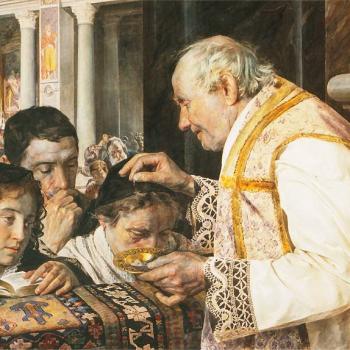It is said of Abba Agathon that he spent a long time building a cell with his disciples. At least when it was finished, they came to live there. Seeing something during the first week which seemed to him harmful, he said to his disciples, ‘Get up, let us leave this place.’ But they were dismayed and replied, ‘If you had already decided to move, why have we taken up so much trouble building the cell?’ People will be scandalized at us, and will say: “Look at them, moving again; what unstable people!” ‘ He saw they were held back by timidity and so he said to them, ‘If some are scandalized, others, on the contrary, will be much edified and say, “How blessed are they who go away for God’s sake, having no other care.” However, let him who wants to come, come; as for me, I am going.’ Then they prostrated themselves to the ground and besought him to allow them to go with him.[1]
The season of the Great Fast, Lent, is forty days, representing both Christ’s forty day retreat into the desert as well as Israel’s forty years of wandering in the desert before their entrance into the Holy Land, the land of promise. With Christ, we are given an example of the retreat we should make many times in our lives so as to be able to attain a higher spiritual awareness, where we too can be directed by the Holy Spirit. With the wandering of Israel in the desert, we are given an example of life itself, where we dwell in a desert, wandering too and fro, seeking the promised land, the kingdom of God, our eschatological goal. We are in the world, living in it, working in it, building it up, but like Abba Agathon, we must be willing to move on when it is time, to not be attached to the good we do, but to always continue our journey forward, to move from good to good, from virtue to virtue, remembering that if we become too attached to the good we have accomplished, we end up declining the good we could and should achieve, ending up stuck where we are and turned away from the end God intends for us.
Reflecting upon the Biblical account of Israel in the desert as an exemplar for life gives us many important insights. We see, for example, the wandering of Israel was not constant; they had many points of rest – the Venerable Bede saying there are forty-two represented in the narrative, indicating the first two and last years of their journey. They show us that we can and do need times of rest, of taking root somewhere, but we must be willing to move on, to hold our ground while unattached to it, willing to abandon it even when the time is to move forward and gain a new virtue, a higher moral ground:
As blessed Jerome explains quite plainly in the book he composed about these things, the successive upward movements of the same resting-places, which advance from their being freed from slavery in Egypt to the land of promise, are the ascent of spiritual virtues seeking the sublime, to which the Church of Christ (and indeed, every faithful soul) hurries to climb in hope of being set free from this vale of tears to go up to the place laid out for it above (that is, to see the God of gods in Zion). As long as we are advancing from virtue to virtue as if to certain camps and resting places, throughout the desert of [this] arid world let us do whatever things are right and proper in the sight of God, secure in the progress of our good work and with our God as leader.[2]
As with Israel, our journey is not always going to be perfect. We will sin, we will fall back and have to regain ground when we lost, through penance. But the grace of God is there and will help correct us and guide us if we are willing. The waters of life will be bitter due to our sin, and will become sweet when mixed with the cross of Christ. Through Christ, everything changes, and nature is elevated so that through grace, we can find joy in life, appreciate it, and yet continue to move forward in our struggle to achieve eternal happiness. “God showed Moses a piece of wood. When he threw it into the water, the water became sweet. The wood is a type of the cross which sweetened the bitterness of the nations. After changing the water, he imposed laws on them, so that just as the wood had the power to alter nature, the law might lure freedom and persuade it.”[3]
Saint Anthony of Padua has another way to look at the forty days and showing how they apply to our daily lives. There are four virtues (prudence, justice, fortitude and temperance) and the Ten Commandments which, of course, are then to be seen as related to each other, so that each virtue has its association with one of the Ten Commandments; he also brings in the traditional four elements, and ten senses – each eye, each ear, each hand and feet being applied to the senses for another variation of the forty, showing two ways he thinks the forty days presents an image of our lives. What is important is that each of these associations presents a place where we might need to repent, and so the forty days of Lent, the forty years in the desert, present to us all kinds of ways we can move forward, all kinds of virtues we can try to attain through engagement of one configuration or another, where we repent of our failings and strive to obtain the virtue opposed to a given vice. “Because every day we sin against the four virtues and the ten commandments, in this mortal body made up of the four elements and ruled by ten senses, we should make satisfaction to the Lord by the fast of forty days.”[4] Each day of Lent can represent a virtue which we strive to obtain, not just in Lent, but in our life. Through St Anthony, we still are to move on from virtue to virtue, remembering not to let our past glory detain us, but we also have a sense of the kind of virtues we can and should seek in the desert of our lives.
The manna from heaven, the manna which the Lord reigned down upon Israel, can be seen as representing many different factors of life. The most important way to see it is as the grace which sustains us in our struggles. Even when we see it as grace, we must remember the synergy involved with grace. We must work with grace, even if we know the greater portion goes to grace (indicated by the way manna was to be collected only six days of the week). But, on those other days, it is to be collected: there is work to be had. Origen presents this to us in his commentary on Exodus, showing we must do good works (acquiring the manna) while nonetheless seeing the role of grace itself in the seventh day, the end of our lives, which turns what we have done and renders it as enough for eternity: “For if you acquire any good work here, if you store away any justice, mercy, and piety, this will be food for you in the world to come.”[5] Only by grace is this possible.
Throughout our lives, as through the period of Lent which exemplifies the journey of life, we are to be watchful, to look for the sins we commit and to root them out. We are to know ourselves, so as to know our dependence on God, but also to know our weaknesses and to root them out. Lent provides us an opportunity to be reminded of this. It is a period of time in which the whole of life is whittled down to forty days. We are brought back to the eternal state of our souls. Will we take the opportunity provided for us and change our ways –or will we find ourselves attached to where we are at and let the opportunity of grace pass us by? It’s up to us. What will we do?
[1] The Sayings of the Desert Fathers. Trans. Benedicta Ward (Kalamazoo, MI: Cistercian Publications, 1984), 21.
[2] Bede, “On the Resting-Places” in Bede: A Biblical Miscellany. Trans. W. Trent Foley and Arthur G. Holder (Liverpool: Liverpool University Press, 1999), 33.
[3] St. Ephrem the Syrian, “Commentary on Exodus” in Selected Prose Works. trans. Edward G. Matthews, Jr. and Joseph P. Amar (Washington, DC: CUA Press, 1994), 254.
[4] St. Anthony of Padua, Sermons For Sundays and Festivals. Volume I. trans. Paul Spilsbury (Padua: Edizioni Messaggero Padova, 2007), 92.
[5] Origen, “Exodus Homily VII” in Origen: Homilies on Genesis and Exodus. Trans. Ronald E. Heine (Washington, DC: CUA Press, 1982), 309.















